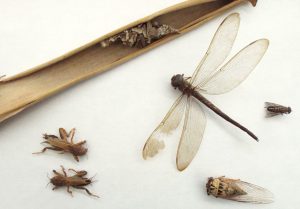 For the past month, I have asked our staff to bring me whatever bugs they might find on our 475-acre farm. This is a very busy time for our faculty and staff, so I only received a few specimens so far, but they are beauties. There’s nothing like coming to work in the morning and finding a mole cricket on your desk. I also received a dog day cicada from Ohio thanks to one of our fiscal assistants who brought it back in her luggage from a trip home!
For the past month, I have asked our staff to bring me whatever bugs they might find on our 475-acre farm. This is a very busy time for our faculty and staff, so I only received a few specimens so far, but they are beauties. There’s nothing like coming to work in the morning and finding a mole cricket on your desk. I also received a dog day cicada from Ohio thanks to one of our fiscal assistants who brought it back in her luggage from a trip home!
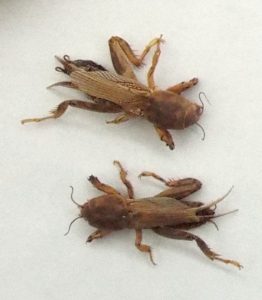 We’ll start with a pair of mole crickets, very common pest in Florida. Family of Gryllotalpidae, in the order of Orthopetera, same as grasshoppers and locusts. They are annoying and destructive, but I think I’ll examine the weird and unusual things I learned about these and the other insects in my fledgling collection. In some parts of Africa if a person sees a mole cricket they might expect good fortune coming their way. In Latin America, mole crickets allegedly predict rain. In Japan they have been known to be associated with the worms of corpses and they send off a person’s sins to heaven. Mole crickets have been part of the human diet in West Java and Vietnam. And in Thailand, mole crickets are quite the delicacy. They are usually eaten fried along with sticky rice.
We’ll start with a pair of mole crickets, very common pest in Florida. Family of Gryllotalpidae, in the order of Orthopetera, same as grasshoppers and locusts. They are annoying and destructive, but I think I’ll examine the weird and unusual things I learned about these and the other insects in my fledgling collection. In some parts of Africa if a person sees a mole cricket they might expect good fortune coming their way. In Latin America, mole crickets allegedly predict rain. In Japan they have been known to be associated with the worms of corpses and they send off a person’s sins to heaven. Mole crickets have been part of the human diet in West Java and Vietnam. And in Thailand, mole crickets are quite the delicacy. They are usually eaten fried along with sticky rice.
Dragonflies are one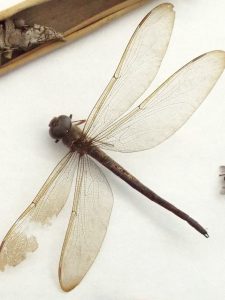 of my favorite and we have plenty here at GCREC. These delicate creatures belong to the order of Odonata, Anisoptera. For some Native American tribes, dragonflies represent swiftness and activity or symbolize pure water. They are a common design in pottery, art and jewelry. They have been used in traditional medicine in Japan and China. Dragonflies are symbols of courage, strength, and happiness in some cultures. In some Asian countries they are fried in oil as a delicious treat. We often see the dragonfly’s little cousin at our center as well – the damselfly suborder Zygoptera in the order Odonata. They have smaller, slimmer bodies, and fold their wings along the body when resting.
of my favorite and we have plenty here at GCREC. These delicate creatures belong to the order of Odonata, Anisoptera. For some Native American tribes, dragonflies represent swiftness and activity or symbolize pure water. They are a common design in pottery, art and jewelry. They have been used in traditional medicine in Japan and China. Dragonflies are symbols of courage, strength, and happiness in some cultures. In some Asian countries they are fried in oil as a delicious treat. We often see the dragonfly’s little cousin at our center as well – the damselfly suborder Zygoptera in the order Odonata. They have smaller, slimmer bodies, and fold their wings along the body when resting.
Of all the insects out in the world, the one I personally despise the most is the common housefly. The main building at GCREC is very large, but for some reason, every fly that gets in the building seems to gravitate to the front desk and thus, buzzes me every chance they can. My small collection includes the worst fly of all, the horsefly. This insect is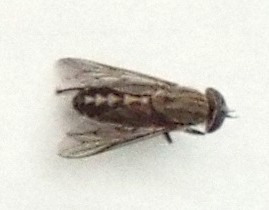 about 10 times bigger than a housefly and 10 times more annoying. Horseflies are in the family Tabanidae in the order of Diptera. They are large, and the females bite humans and animals to obtain blood. They feed on the blood of mammals in order to assist in egg development. On the flip side, I could not find any information on human consumption of flies and considering where they usually reside, I can see why.
about 10 times bigger than a housefly and 10 times more annoying. Horseflies are in the family Tabanidae in the order of Diptera. They are large, and the females bite humans and animals to obtain blood. They feed on the blood of mammals in order to assist in egg development. On the flip side, I could not find any information on human consumption of flies and considering where they usually reside, I can see why.
Imported Locust from Ohio. I have been in Florida for 35 years, but I remember all too well when a locust or cicadas would suddenly appear in your car and buzz for what seemed hours in the rear window attempting to escape. However, their loud, raspy call used to attract females is one of my favorite summer sounds. One of our fiscal assistants found this dog day locust in her mo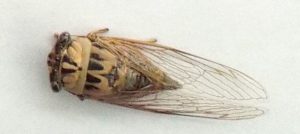 ther’s vehicle during a trip home last month and brought it to Florida in a tiny box. Locust or cicadas are in the Cicadidae family and the order Hemiptera. This example is the annual cicadas/locust, not the famed 13- or 17-year cicadas. The 17-year cicadas are expected this summer. In some countries you might find breaded locust and chocolate-covered locust on the menu. Even covered in chocolate is not enough of a temptation for me to try one.
ther’s vehicle during a trip home last month and brought it to Florida in a tiny box. Locust or cicadas are in the Cicadidae family and the order Hemiptera. This example is the annual cicadas/locust, not the famed 13- or 17-year cicadas. The 17-year cicadas are expected this summer. In some countries you might find breaded locust and chocolate-covered locust on the menu. Even covered in chocolate is not enough of a temptation for me to try one.
The final specimen in my new collection is a bagmoth cocoon. Bagmoths are from the family of the Lepidoptera, which includes all butterflies and moths. The caterpillar stage of this moth will construct cases out of silk and sand, soil, plant material, twigs, basically whatever is available i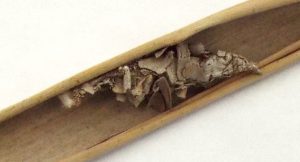 n their environment. These cocoons are usually attached to rocks, trees or structures while during their development stage. The males live just long enough to mate. The females, which are wingless, wait for the mating process, lay their eggs and die. Seems like a sad, short life indeed. Their cocoons can be quite elaborate depending on what they find when they are building their case.
n their environment. These cocoons are usually attached to rocks, trees or structures while during their development stage. The males live just long enough to mate. The females, which are wingless, wait for the mating process, lay their eggs and die. Seems like a sad, short life indeed. Their cocoons can be quite elaborate depending on what they find when they are building their case.
So this is our contribution to the weird and wonderful Bug Week at UF/IFAS! GO ARTHROPODS!
 0
0
